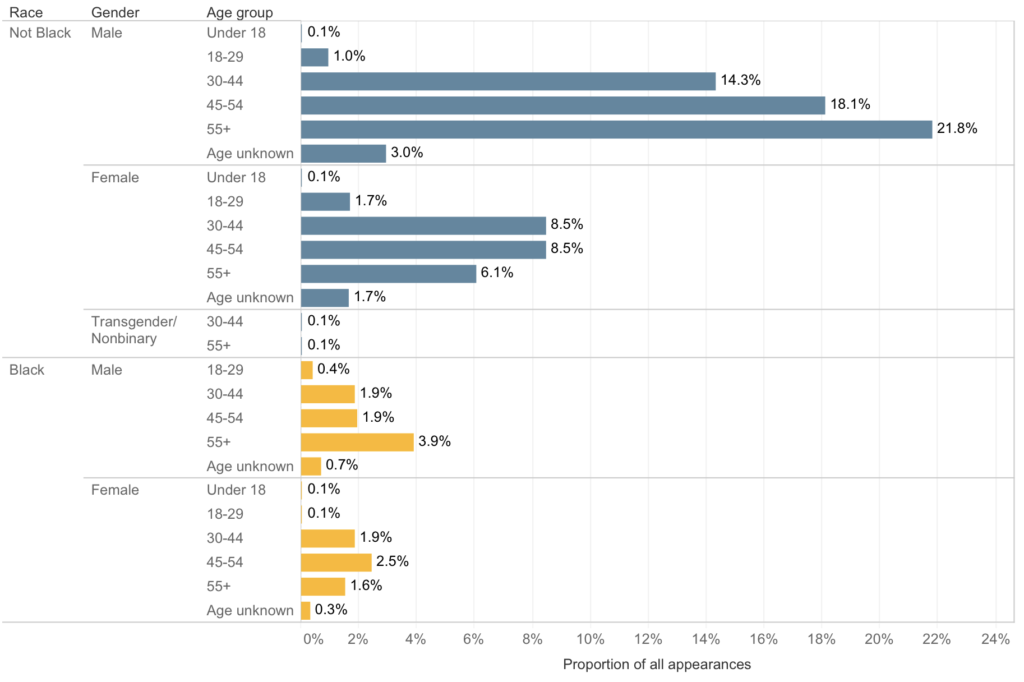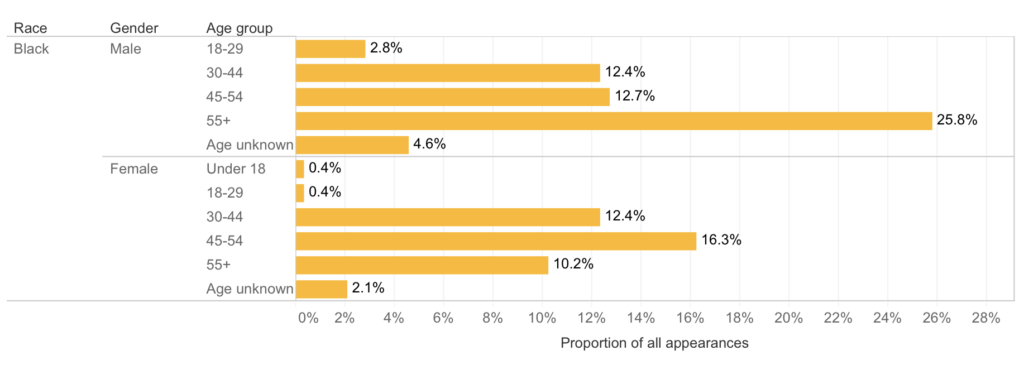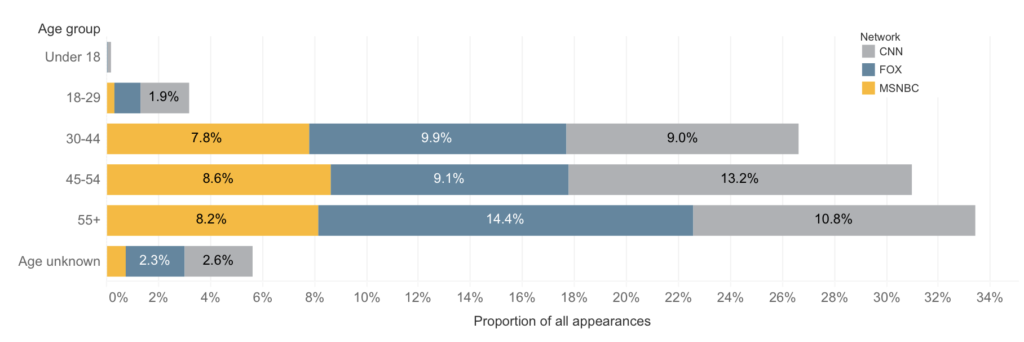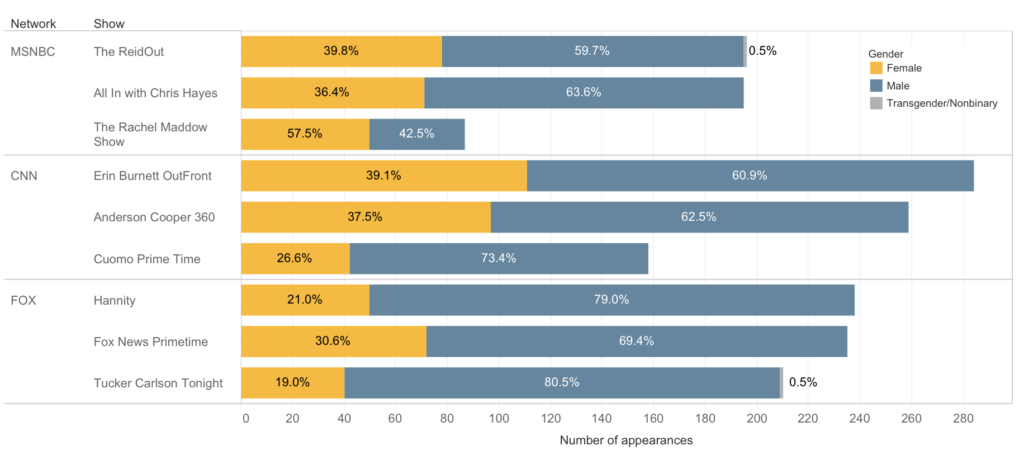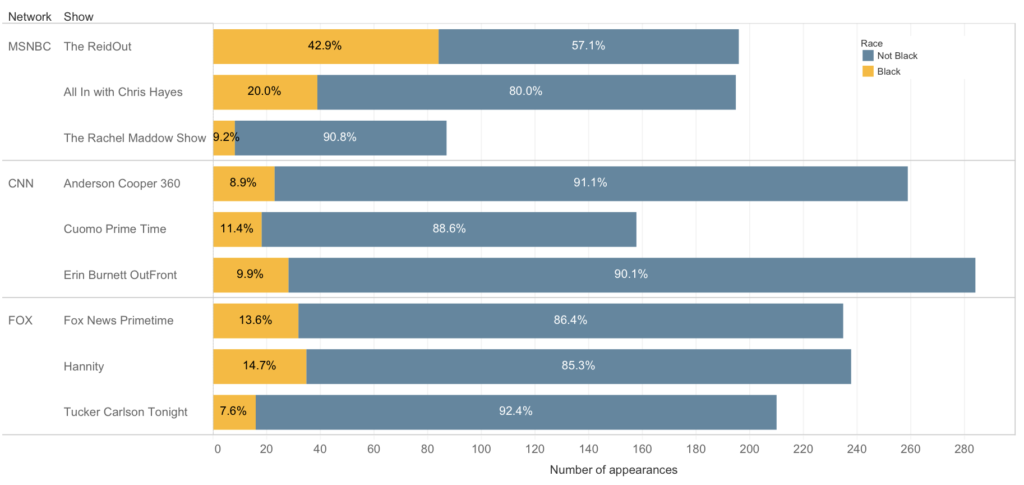Who’s at the primetime table? An analysis of host, contributor, and guest appearances on six weeks of primetime cable news
Monday, September 13, 2021Cable news programming offers a window into public debate for a broad swath of Americans, including many older and politically active audiences. Its reach has been magnified by the events of 2020 and 2021,1 including a global pandemic that kept people in their homes, a highly publicized national racial reckoning, and a contentious presidential election followed by a violent aftermath at the U.S. Capitol. Cable news amplifies political debate and validates thought leaders and experts in the public square, propelling vital voices who shape policy and can affirm democratic values like equity and inclusion.
Black women — especially older Black women who can provide perspectives from potent lived experience as advocates, civic leaders, and experts in a vast array of sectors and subjects — should be among the prominent voices on the coveted primetime lineup of major cable news networks. They are overperformers in electoral politics,2,3 advanced degrees,4,5 and business ownership.6,7 Yet they are often erased from spaces where they should command a place. And older Black women should be visible in cable television news because they represent an important audience for this programming. The three major cable networks — CNN, Fox, MSNBC — all skew toward older viewers, and a majority of women comprise MSNBC and CNN audiences,8 which both enjoy a Black viewership larger than their percentage in the general population.
In short, we wanted to know: Given all their contributions to public and political life, are older Black women visible on primetime cable news?
We zeroed in on age, race, and gender for a quantitative snapshot of who the three major networks elevate as experts in the political and cultural debates that shape our world — and, perhaps more importantly, whose voices are left out.
Our findings
To answer this question, we systematically examined who appears on primetime news programming on CNN, Fox, and MSNBC, Monday through Friday from 7 p.m. to 10 p.m. The review period included nine programs over six weeks from May 24 through June 30, 2021. This period included the one-year anniversary of George Floyd’s murder by Minneapolis police as well as the inaugural Juneteenth federal holiday — events that both would necessarily be enhanced by perspectives from Black commentators, including Black women.
During the six weeks of our analysis, we documented 1,862 appearances by a host, contributor, or guest. Our findings revealed a dearth of Black voices occupying influential seats on primetime cable news. Black women of all ages are sorely missing, but most dramatically, those 55 and older represent a scant 1.6% of all appearances. Of the 1,862 appearances logged during the review period, Black women 55 and older constituted just 21 appearances; though, due to a few multiple bookings, they appeared a total of 28 times.
Who’s at the primetime table?
Men over 45 who are not Black most frequently appeared on primetime cable news. Across networks, men who did not present or identify as Black appeared most often on primetime cable news, with men over 55 accounting for one in five appearances, followed by men aged 45-54 (see Figure 1). Women in their 30s, 40s, and 50s who did not identify or present as Black accounted for significantly fewer appearances, but still far exceeded appearances by Black men and women of all ages.
Figure 1. Proportion by racial, gender, and age presentation of hosts, contributors, and guests on primetime news shows that aired from May 24, 2021 through June 30, 2021 (n=1,862 appearances).
When Black people did appear on cable news, they were most often men aged 55 and over, while older Black women seldom appeared.
Black people seldom appeared on cable news — and older Black women were uniquely underrepresented. During the period of our analysis, there were 28 appearances by Black women 55 and over, accounting for 10% of appearances by Black people (see Figure 2), but only 1.6% of all appearances (see Figure 1). By contrast, Black men 55 and over accounted for one-quarter of all appearances by Black people (see Figure 2).
Figure 2. Proportion by racial, gender, and age presentation of Black hosts, contributors, and guests on primetime news shows that aired from May 24, 2021 through June 30, 2021 (n=284 appearances by Black people).
When Black women 55 and over did appear, they most often were guests on MSNBC: 4% of all appearances on the network were made by Black women in this age range. The Rachel Maddow Show had the highest percentage of Black women 55 and over as guests (6% of all appearances on the show).
Other networks featured Black women 55 and over even less frequently. Only 1% of all appearances of CNN were by Black women 55 and over, and Black women 55 and over appeared even less often (< 1%) on FOX. Indeed, only one Black woman 55 and over appeared on the FOX News Primetime show, and no older Black women at all appeared on Hannity or Tucker Carlson Tonight on FOX during our analysis period.
Of the 21 Black women 55 and over who appeared, six were elected officials, and the others were racial justice advocates, legal experts, journalists, and scholars (see Table 1). Many older Black women who appeared were invited to speak on issues such as voting rights, police accountability, and Juneteenth as a national holiday.
Table 1. Black women aged 55 and over who appeared as hosts, contributors, or guests on primetime cable news programs on CNN, FOX, and MSNBC between May 24, 2021 and June 30, 2021.
| Name | Profession | Network | Show |
|---|---|---|---|
| Ann Simmons | Journalist | MSNBC | The Rachel Maddow Show |
| Annette Gordon-Reed | Historian, law professor | MSNBC | The ReidOut |
| Areva Martin | Attorney, media expert | CNN | Erin Burnett OutFront |
| Barbara Lee | Member of Congress | MSNBC | The Rachel Maddow Show |
| Carol Anderson | Academic, historian, author “White Rage” | MSNBC | All In with Chris Hayes |
| Donna Edwards | Former member of Congress, MSNBC contributor | MSNBC | All In with Chris Hayes |
| Dorothy Brown | Historian, scholar | MSNBC | All In with Chris Hayes |
| Helen Butler | Racial justice advocate | CNN | Erin Burnett OutFront |
| Helene Cooper | Journalist | MSNBC | All In with Chris Hayes |
| Judith Browne Dianis | Attorney, racial justice advocate | MSNBC | All In with Chris Hayes, The Rachel Maddow Show |
| Karen Bass | Member of Congress | CNN, MSNBC | Cuomo Prime Time, The ReidOut |
| Kimberlé Crenshaw | Scholar, racial justice advocate | MSNBC | The ReidOut |
| Lauren Green | FOX chief religion correspondent | FOX | Fox News Primetime |
| Maxine Waters | Member of Congress | MSNBC | The ReidOut |
| Maya Wiley | MSNBC (former) legal contributor, racial justice advocate | CNN | Erin Burnett OutFront |
| Mona Hardin | Community resident whose son was killed by police | CNN, MSNBC | Anderson Cooper 360, The ReidOut |
| Opal Lee | Activist, Juneteenth movement | CNN | Cuomo Prime Time |
| Regina Goodwin | State representative | MSNBC | The Rachel Maddow Show |
| Sheila Jackson Lee | Member of Congress | CNN, MSNBC | Erin Burnett OutFront, All In with Chris Hayes |
| Sherrilyn Ifill | Attorney, racial justice advocate | MSNBC | All In with Chris Hayes, The Rachel Maddow Show |
| Val Demings | Member of Congress | CNN, MSNBC | Erin Burnett OutFront, All In with Chris Hayes, The ReidOut |
People aged 45 and older accounted for the bulk of appearances on cable news.
Perhaps because viewership for the three major cable networks skews older,9 the hosts, contributors, and guests who appear on primetime cable news tend to be older as well. More than 60% of all appearances on cable news programming during the six weeks of our analysis were by people aged 45 or older. People aged 55 and over accounted for one-third of appearances, followed by people aged 45-54 (see Figure 3). People in their 30s and early 40s comprised just over one-quarter of appearances, while young people and teens rarely appeared at all. People aged 55 and over were the most likely to appear on FOX News, while people aged 18-29 were most likely to appear on CNN. Specifically, almost half (43%) of all appearances by hosts, contributors, and guests aged 55 or over were on FOX News. By contrast, the bulk of appearances by people aged 18-29 were on CNN (59% of all appearances in that age range).
People aged 55 and over were the most likely to appear on FOX News, while people aged 18-29 were most likely to appear on CNN. Specifically, almost half (43%) of all appearances by hosts, contributors, and guests aged 55 or over were on FOX News. By contrast, the bulk of appearances by people aged 18-29 were on CNN (59% of all appearances in that age range).
Figure 3: Proportion, by age, of appearances by hosts, contributors, and guests on CNN, FOX, and MSNBC programs that aired from May 24, 2021 through June 30, 2021 (n=1,862 total appearances).
We were unable to verify the age of nearly 6% of people who appeared; many of those whose ages we could not identify were not public figures (such as, for example, family members of those harmed, killed, or missing in the collapse of the Champlain Towers South in Florida) and, therefore, did not have access to public information about their age.
More men than women appeared on primetime cable news, and trans voices were almost entirely absent.
People who presented or identified as male accounted for 67% of all appearances, while female-identified people accounted for only 33% (see Figure 1). Only two individuals who identified as gender nonbinary or transgender made an appearance during the analysis period, accounting for 0.1% of the total.
For all but one of the nine shows, appearances by male contributors or guests far exceeded appearances by females. However, over half of guest or contributor appearances on The Rachel Maddow Show — the show with the fewest guest appearances overall — were women.
Figure 4: Proportion, by gender presentation, of appearances by hosts, contributors, and guests on CNN, FOX, and MSNBC programs that aired from May 24, 2021 through June 30, 2021 (n=1,862 total appearances).
Few Black hosts, contributors, or guests appeared on primetime cable news.
There were 284 appearances by hosts, contributors, or guests who presented as Black (including guests who identified as Afro-Latinx or as mixed-race), representing 15% of all appearances across networks.
Figure 5. Proportion, by racial presentation, of appearances by hosts, contributors, and guests on CNN, FOX, and MSNBC programs that aired from May 24, 2021 through June 30, 2021 (n=1,862 appearances).
As illustrated in Figure 5, MSNBC boasted more appearances by Black voices (27%) than either FOX (12%) or CNN (10%) combined. MSNBC also airs the only primetime cable news show with a full-time Black host. Almost half (43%) of appearances on Joy Reid’s show, The ReidOut, were Black people — significantly more than any other program we analyzed (see Figure 6).
Figure 6. Proportion, by racial presentation, of hosts, contributors, and guests on primetime news shows that aired from May 24, 2021 through June 30, 2021 (n=1,862 appearances).
Women and Black people rarely appeared as hosts of primetime cable news
Guests on cable news may come and go, but hosts are on the air every day. We coded demographic information for all main hosts, as well as any replacement or guest hosts who appeared. Across networks, most hosts were male (see Table 2). FOX News had the lowest proportion of female hosts: Only two women (Tammy Bruce and Jeanine Pirro) appeared as guest hosts on FOX News Primetime, which sponsors a rotating roster of guest hosts. In addition, only two hosts across networks presented as Black, including Joy Reid of MSNBC and Lawrence Jones, an occasional fill-in guest host on FOX News.
Table 2: Demographics of all hosts during the review period (including principals and fill-in hosts) (n=25 people)
Network Male Female Black Age 55+ N % N % N % N % MSNBC (N=5) 3 60% 2 40% 1 20% 0 0% CNN (N=8) 4 50% 4 50% 0 0% 1 13% FOX (N=12) 10 83% 2 17% 1 8% 1 8%
Summary and conclusions
Our analysis of six weeks of primetime cable TV news from May 24 through June 30, 2021 revealed:
- The voices and expertise of older Black women are largely excluded, even in comparison to older Black men;
- Black hosts, contributors, and guests comprise a miniscule percentage of the primetime lineup;
- Cable news programs overrepresent the perspectives of people who present or identify as men, particularly men aged 45+;
- Men identified as non-Black dominate in primetime programming, in significantly greater numbers than non-Black women across all age categories.
Our findings shed light on persistent patterns of exclusion and inequity at the major cable networks in the coveted primetime slots. Although this analysis encompasses only six weeks of coverage, the period of review included the anniversary of George Floyd’s murder and the Juneteenth observance that was inaugurated as a federal holiday — two events that call for interpretation from Black commentators. However, even during a time when we would assume there might be a larger number of Black voices at the table, only 15% of appearances were by Black men and women, and, of those, only 10% were by older Black women. Even among hosts and contributors — the standard bearers who are regular faces in the primetime lineup throughout the year — Black people, women, and older Black women, in particular, were underrepresented.
Our findings point to the critical need to expand representation on primetime news — not only to include more Black women aged 55 and older but also to broaden the tent for everyone who is underrepresented in this important space where our nation’s thorniest issues are debated. Inclusion and elevation of commentators who look more like America is a key step toward strengthening and democratizing the national discourse that the media shape and elevate. Everyone will benefit if cable primetime news programs expand whom they invite to the table to share in our national discussion.
Note on research methods
We searched the news database on LexisNexis to retrieve television news transcripts of nine cable primetime news shows (that is, shows that aired between 7 p.m. and 10 p.m. on weeknights) from May 24, 2021 through June 30, 2021. In total, we retrieved 245 transcripts.
For each host, contributor, and guest in each program, we identified the individual’s name, their gender presentation (female, male, nonbinary, transgender), racial presentation (Black or not Black), age (in years), profession, and area of expertise. If information about any of these variables was not available in the transcript, we searched Google for publicly available information (such as wedding announcements, media profiles, Wikipedia entries, etc.).
Our assessment of subjects’ race was based on images and written identifications, including, for example, biographical notes like, “Val Demmings [is] a member of the Congressional Black Caucus.” Though race is not a binary, our analysis focused on representation or absence of Black voices, specifically. To that end, we categorized each subject’s racial presentation as Black or not Black, but we recognize and acknowledge the dramatic and unacceptable underrepresentation of other non-White hosts, contributors, and guests from indigenous, Latinx, API, and other communities whose identities are not specifically named using this binary coding approach.
When necessary, we determined gender presentation by reviewing the subject’s public statements and assessing which pronouns they used. In addition, for people whose ages were not publicly available, we used information such as year of college graduation or length of employment.
Prior to and during coding, trained coders held conversations to achieve consensus to ensure that agreement on issues of age, race, and gender did not occur by chance.
Acknowledgments
This study was commissioned by Unerased | Black Women Speak, with funding from the Black Women’s Roundtable of the National Coalition on Black Civic Participation, Craig Newmark Philanthropies, and “Anonymous Donors.” BMSG’s research benefited from the insights and reflections from the Black Women Unerased team, especially Gwen McKinney, Llenda Jackson-Leslie, and Bria Russ.
References
1. Porter R. Pandemic, election push cable news channels to peak in 2020. The Hollywood Reporter. Published December 22, 2020. Accessed August 17, 2021. https://www.hollywoodreporter.com/tv/tv-news/pandemic-election-push-cable-news-channels-to-peak-in-2020-4108610/.
2. Meeks L. Believing Black women. Election analysis – United States. Accessed August 23, 2021. https://www.electionanalysis.ws/us/president2020/section-2-voters/believing-black-women/.
3. Connley C. How Stacey Abrams, LaTosha Brown and other Black women changed the course of the 2020 election. CNBC. Published November 6, 2020. Accessed August 23, 2021. https://www.cnbc.com/2020/11/06/black-women-continue-to-be-the-democratic-partys-most-powerful-weapon.html.
4. Katz N. Black women are the most educated group in the U.S. ThoughtCo. Published June 20, 2020. Accessed August 23, 2021. https://www.thoughtco.com/black-women-most-educated-group-us-4048763.
5. Reeves R, Guyot K. Black women are earning more college degrees, but that alone won’t close race gaps. Brookings. Published December 4, 2017. Accessed August 23, 2021. https://www.brookings.edu/blog/social-mobility-memos/2017/12/04/black-women-are-earning-more-college-degrees-but-that-alone-wont-close-race-gaps/.
6. Umoh R. Black women were among the fastest-growing entrepreneurs — then Covid arrived. Forbes. Published October 26, 2020. Accessed August 23, 2021. https://www.forbes.com/sites/ruthumoh/2020/10/26/black-women-were-among-the-fastest-growing-entrepreneurs-then-covid-arrived/?sh=aa0218e6e011.
7. Kelley D, Majbouri M, Randolph A. Black women are more likely to start a business than white men. Harvard Business Review. Published May 11, 2021. Accessed August 23, 2021. https://hbr.org/2021/05/black-women-are-more-likely-to-start-a-business-than-white-men.
8. Greico E. Americans’ main sources for political news vary by party and age. Pew Research Center. Published April 1, 2020. Accessed August 17, 2021. https://www.pewresearch.org/fact-tank/2020/04/01/americans-main-sources-for-political-news-vary-by-party-and-age/.
9. Stoll J. Frequency of using cable news as source of news among adults in the United States as of March 2020, by age group. Statista. Published June 4, 2021. Accessed August 17, 2021. https://www.statista.com/statistics/742225/frequency-of-watching-cable-news-in-the-us-age/.





